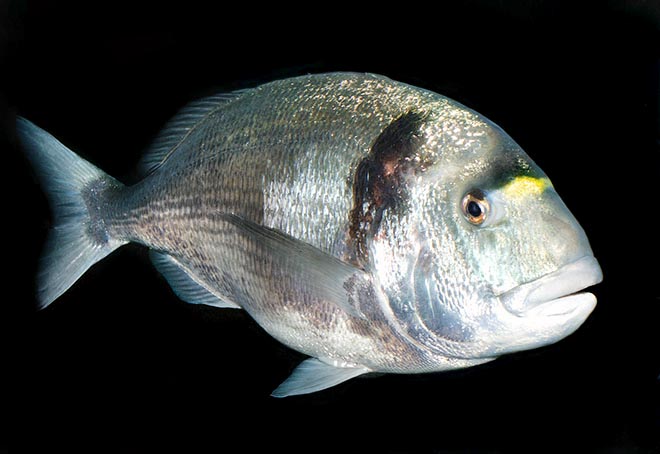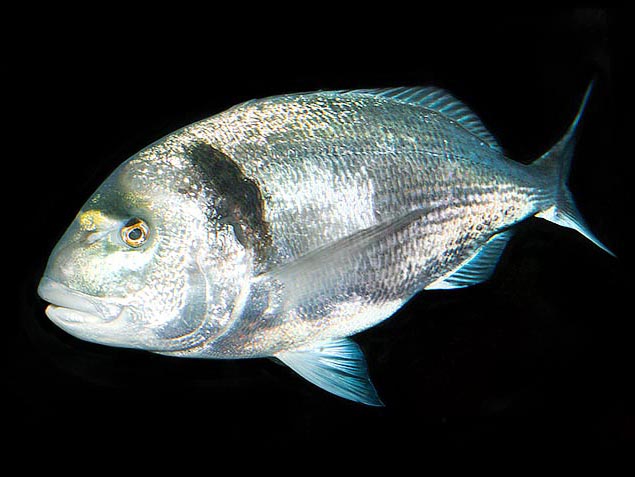Family : Sparidae

Text © Giuseppe Mazza

English translation by Mario Beltramini

The gilt head bream (Sparus auratus) is characterized, as the name says, by a golden dot between the eyes © Giuseppe Mazza
The name of the genus gets its origin from the Latin “sparus” = spear, due to the shape of the fish recalling the shape of the metallic glittering tip of this ancient weapon.
The name of the species comes from the Latin “auratus” = golden, due to the typical golden band between the eyes.
Zoogeography
It is present in the whole Mediterranean, Black Sea included, where, however, its population is rather modest, and, after Gibraltar Strait, it is found along the eastern Atlantic coast, from England to Mauritania, including the Azores, Cape Verde, Madeira and Canary Islands.
Ecology-Habitat
The gilt head bream lives along the coasts up to 30 m of depth. It is often found almost in surface, but it may even go down, exceptionally, up to 150 m. It frequents the rocky locations, the seagrass meadows of Posidonias (Posidonia oceanica) and the sandy seabeds. When it is not too much fished, it lives in schools with individuals of different size headed by the elders; otherwise, as often is the case of the Mediterranean, it carries on an isolated life. It is a decidedly euryhaline species so much that, before reproducing, it spends a good part of the summer in the coastal brackish waters or in the estuaries.
Morpho-physiology
It can reach the 70 cm and the 10 kg of weight, but the most common specimens measure 35-40 cm. The head is short and stocky, with big lips and robust jaws. The upper one is slightly longer and both carry 4-6 caniniform teeth, followed by others, smaller, and by various rows of molariform ones. The dorsal fin, unique and retractile into a suitable dorsal groove, counts 11 spiny rays and 13 unarmed; the anal, 3 spiny rays and 11-12 soft, whilst the ventral ones have one only spine with 5 unarmed rays. The pectoral fins are long and pointed. The caudal is slightly forked with dark edge.

When three, the males turn to females and may reach the 70 cm and 10 kg of weight © Giuseppe Mazza
Ethology-Reproductive Biology
The gilt head bream may live 11 years, nourishing mainly of crustaceans and molluscs, especially mussels, it detaches, by means of its solid incisory teeth, from the rocks and happily chews with its molars. Useless to say that this sort of marine nutcracker is not beloved by the breeders of mussels and of oysters, which it crushes, just like that, with its strong jaws.
Even if, occasionally, it enriches the diet with seaweeds, it is clear; with these premises, that the flesh of the gilt head bream is very valuable. Too much fished, it is protected by laws establishing the minimum size of the meshes of the nets, which, for instance, is of 20 cm in the French Mediterranean, and the ever increasing demand of the supermarkets and the restaurants has made to sprout, like fungi, farmings in various countries. It is obvious, however, that, but health hazards, the taste is not the same, and that seen the limited mobility in the cages, and the too abundant food, the flesh of these fishes is significantly more fat.
The Sparus aurata is a protandric hermaphrodite species: this means that the males become females, around the third year of age. Between October and December, the males leave the brackish waters, where they often enter in spring for spending the summer, and reach the sea. Thousands of pelagic eggs of about 1 mm of diameter are spawned, and from these come to life 2,5-3 mm larvae which grow up very quickly. The gilt head breams terribly fear the cold, and when they linger in the shallow waters of the Venetian lagoon, they have noted that, at times, in order not freeze to death, they are obliged to slip in the mud. It’s their Achilles heel, and in the farms they kill them in this way, with a thermal shock, throwing them into the iced water.
The vulnerability index of this species is of 40 over 100.
Synonyms
Aurata aurata Linnaeus, 1758; Chrysophrys aurata Linnaeus, 1758; Chrysophrys crassirostris Valenciennes, 1830; Pagrus auratus Linnaeus, 1758; Sparus auratus Linnaeus, 1758.
→ For general information about FISH please click here.
→ For general information about BONY FISH please click here
→ For general information about CARTILAGINOUS FISH please click here.
→ To appreciate the BIODIVERSITY of BONY FISH please click here.
→ To appreciate the BIODIVERSITY of CARTILAGINOUS FISH please click here.
